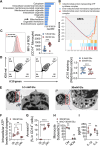Monocytes perturbation implicated in the association of stress hyperglycemia with postoperative poor prognosis in non-diabetic patients with Stanford type-A acute aortic dissection
- PMID: 39462406
- PMCID: PMC11520058
- DOI: 10.1186/s12933-024-02468-9
Monocytes perturbation implicated in the association of stress hyperglycemia with postoperative poor prognosis in non-diabetic patients with Stanford type-A acute aortic dissection
Abstract
Objectives: The study aimed to investigate the interaction of intraoperative stress hyperglycemia with monocyte functions and their impact on major adverse events (MAEs) in acute aortic dissection (AAD) patients who underwent open repair surgery.
Methods: A total of 321 adults who underwent open surgery for AAD at two tertiary medical centers in China were enrolled in the study. The primary endpoint was defined as the incidence and characteristics of perioperative stress hyperglycemia. The secondary endpoints included the incidence of postoperative MAEs, postoperative monocyte counts and inflammatory cytokine expression. Multi-logistic, linear regression and receiver operating characteristic (ROC) curve analyses were used to establish relationships between intraoperative time-weighted average glucose (TWAG), day-one postoperative monocyte counts, serum inflammatory cytokines and postoperative outcomes. In addition, in vitro experiments were conducted to evaluate changes in the inflammatory features of monocytes under high glucose conditions.
Results: Intraoperative hyperglycemia, as indicated by a TWAG level over 142 mg/dL, was associated with elevated postoperative monocyte counts and inflammatory cytokines, which correlated with extended intensive care unit (ICU) stays and worsened outcomes. In vitro, high glucose treatment induced mitochondrial impairment in monocytes, increased the release of inflammatory cytokines and the proportion of classical monocytes from AAD patients.
Conclusions: Intraoperative stress hyperglycemia, in combination with day-one postoperative monocyte counts, were clinically significant for predicting adverse outcomes in AAD patients undergoing open repair surgery. Elevated glucose concentrations shaped the inflammatory features of monocytes in AAD by impairing mitochondrial functions.
Keywords: Acute aortic dissection; Inflammation; Mitochondria; Monocyte; Stress-Induced hyperglycemia.
© 2024. The Author(s).
Conflict of interest statement
The authors declare no competing interests.
Figures





References
-
- Carrel T, Sundt TM 3rd, von Kodolitsch Y, Czerny M. Acute aortic dissection. Lancet. 2023;401(10378):773–88. - PubMed
-
- Golledge J, Eagle KA. Acute aortic dissection. Lancet. 2008;372(9632):55–66. - PubMed
-
- Trimarchi S, Nienaber CA, Rampoldi V, Myrmel T, Suzuki T, Mehta RH, et al. Contemporary results of surgery in acute type a aortic dissection: the international registry of acute aortic dissection experience. J Thorac Cardiovasc Surg. 2005;129(1):112–22. - PubMed
-
- Knipp BS, Deeb GM, Prager RL, Williams CY, Upchurch GR Jr., Patel HJ. A contemporary analysis of outcomes for operative repair of type A aortic dissection in the United States. Surgery. 2007;142(4):524–8. discussion 8.e1. - PubMed
Publication types
MeSH terms
Substances
Grants and funding
LinkOut - more resources
Full Text Sources
Medical

